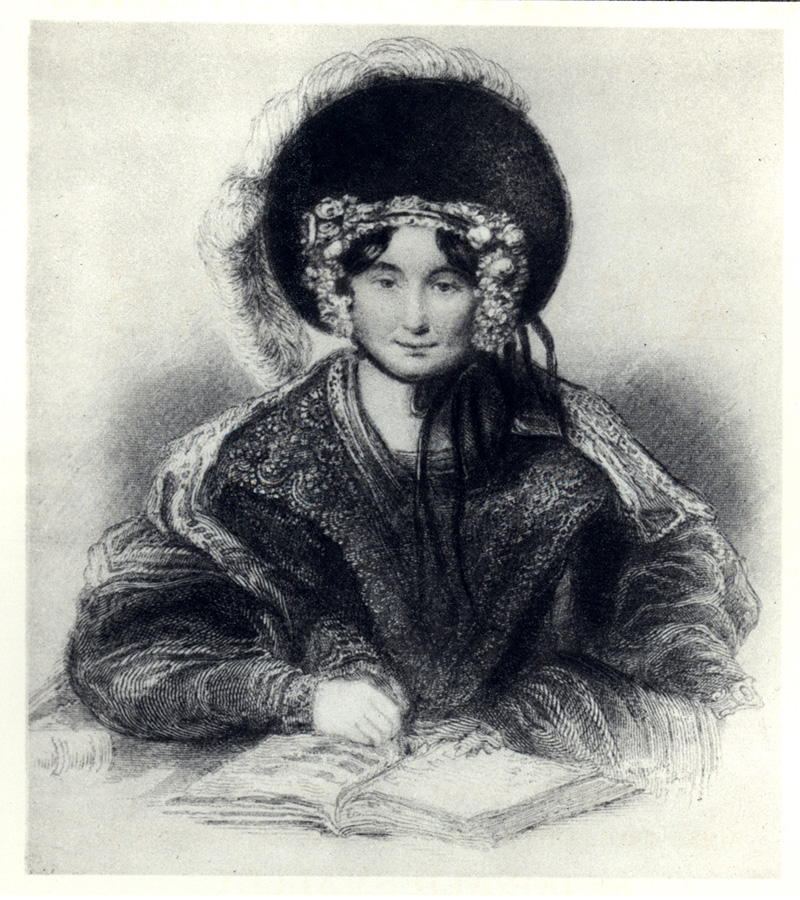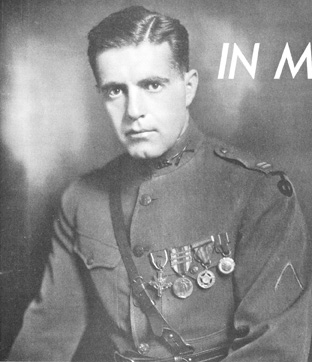 October is German-American Heritage Month, and there could not be a better time to explore ARB’s German-Americana collection. The German-Americana Collection is one of the nation’s largest collections pertaining to German-American history, literature and culture, and is located in the Archives and Rare Books Library in Blegen Library. In 1935, the University of Cincinnati acquired the seed collection for what is today’s German-Americana collection with the library of H.H. Fick. Fick, a German immigrant and a former teacher with the Cincinnati Public Schools, spent his final years collecting books and pamphlets on German-American history and culture. The donation also contained Fick’s own writings and autobiography. Continue reading
October is German-American Heritage Month, and there could not be a better time to explore ARB’s German-Americana collection. The German-Americana Collection is one of the nation’s largest collections pertaining to German-American history, literature and culture, and is located in the Archives and Rare Books Library in Blegen Library. In 1935, the University of Cincinnati acquired the seed collection for what is today’s German-Americana collection with the library of H.H. Fick. Fick, a German immigrant and a former teacher with the Cincinnati Public Schools, spent his final years collecting books and pamphlets on German-American history and culture. The donation also contained Fick’s own writings and autobiography. Continue reading
Tag Archives: Cincinnati History
T. M. Berry Project: Fred Shuttlesworth
By Laura Laugle
For many people familiar with the American Civil Rights Movement, the recent death of Fred Shuttlesworth marks the end of an era. Shuttlesworth was the last surviving member of “The Big Three” a descriptor for the three founding members of the Southern Christian Leadership Conference, Rev. Dr. Martin Luther King, Rev. Ralph Abernathy and Rev. Fred Shuttlesworth.
Though Shuttlesworth is predominately known for his work in Birmingham, Alabama, he actually lived much of his life right here in Cincinnati. He moved here in 1961 to take a position as pastor at Revelation Baptist Church and met the Berry family when he moved into their former home on North Crescent Ave. Although he continued his involvement in the Civil Rights Movement mostly through his work with the Southern Christian Leadership Conference in Alabama, he did have a few special projects going in the which city he called home until his retirement in 2007 which would have been important to Ted Berry, particularly later in their careers. Continue reading
T. M. Berry Project: The New Horizon
By Laura Laugle
Now that the physical processing of the Berry collection is complete and I’ve begun arranging materials, I’ve come across some items which, when I processed them months and months ago, I was too ignorant of their context to fully appreciate. Chief among those items are three copies of The New Horizon. I had no idea when I pulled out the rusty staples, pried off the bits of rapidly disintegrating paperclips and filed them temporarily (read: labeled with a removable sticky note) as “Misc. Copies of New Horizon” how incredibly important these school papers really are. Continue reading
College of Music Historical Collection in ARB
By Lauren Fink
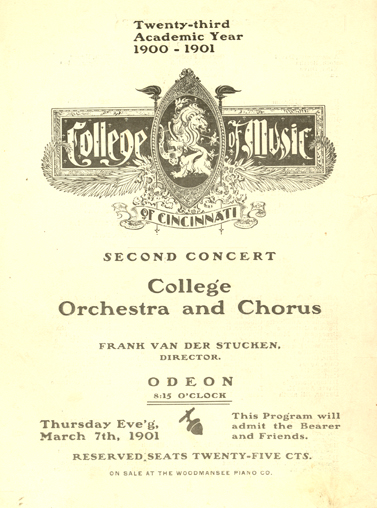 In the Archives and Rare Books Library, we recently processed a collection containing historical records of the College of Music of Cincinnati. This collection spans 1878-1967 and contains commencement bulletins, programs, student rosters, and minutes of executive, financial, and stockholder’s committee meetings. Illustrating the historical and biographical nature of this collection, the 1926 commencement bulletin entitled “College Comments,” contains articles on the College’s faculty, graduating students, clubs, and ensembles. Further, meeting minutes provide details of all of the College’s major educational and financial concerns and
In the Archives and Rare Books Library, we recently processed a collection containing historical records of the College of Music of Cincinnati. This collection spans 1878-1967 and contains commencement bulletins, programs, student rosters, and minutes of executive, financial, and stockholder’s committee meetings. Illustrating the historical and biographical nature of this collection, the 1926 commencement bulletin entitled “College Comments,” contains articles on the College’s faculty, graduating students, clubs, and ensembles. Further, meeting minutes provide details of all of the College’s major educational and financial concerns and 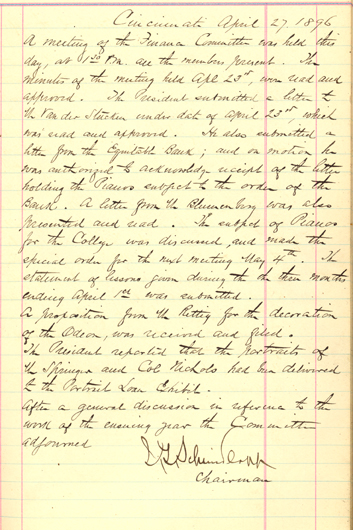 decisions, such as how to create more space for radio labs or the necessity of hiring certain faculty for certain departments. The minutes also contain outlines of correspondence between the College and the Conservatory of Music on having a connection with each other. To view the contents of this new collection, see the finding aid online (http://rave.ohiolink.edu/archives/ead/OhCiUAR0287). Continue reading
decisions, such as how to create more space for radio labs or the necessity of hiring certain faculty for certain departments. The minutes also contain outlines of correspondence between the College and the Conservatory of Music on having a connection with each other. To view the contents of this new collection, see the finding aid online (http://rave.ohiolink.edu/archives/ead/OhCiUAR0287). Continue reading
Historical City of Cincinnati Birth and Death Records Now Available Online
The City of Cincinnati Birth and Death Records from 1865 to 1912 are now fully online and available for research and study at http://digitalprojects.libraries.uc.edu/Births_and_Deaths/.
T. M. Berry Project: Proportional Representation in Cincinnati
By Laura Laugle
A large part of Theodore M. Berry’s work in obtaining equality for African Americans in Ohio and especially in Cincinnati centered on the electoral process. The “Berry Backers” frequently ran “Get out the Vote” type events throughout the 1940s and 1950s, using the lure of bowling tournaments and visiting speakers like Dr. Martin Luther King, Jr. to encourage blacks to work with the systems in place and become involved in the political process. It should then come as no surprise that Berry spent many years fighting for what he believed to be the fairest system of voting – proportional representation.
An Alma Mater Moment
By Kevin Grace
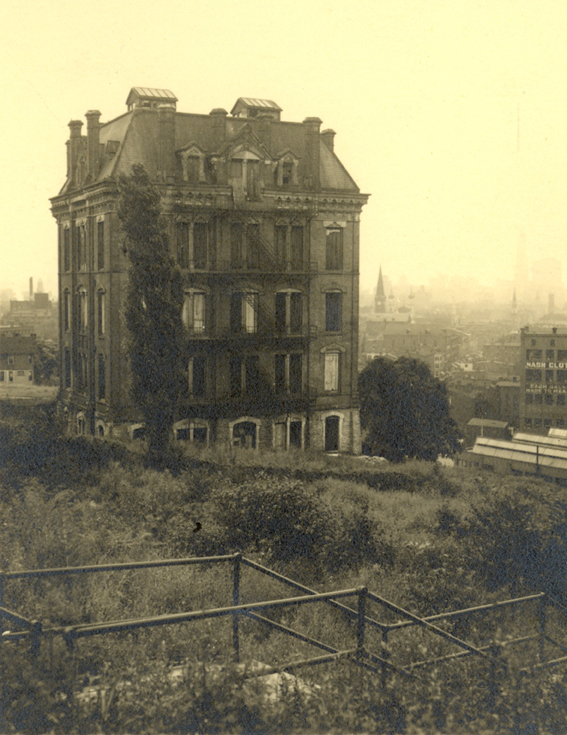 Over the years, I’ve gathered a fair amount of UC ephemera from garage sales, flea markets, estate sales, and Ebay, and eventually I’ll end up giving it to the University Archives. In the meantime, it’s always a nice little surprise when I dig around in my basement boxes and find these odds and ends. The postcard shown here is of the original University Building, constructed on Charles McMicken’s property in 1875. That property had been bequeathed to the City of Cincinnati in McMicken’s will when he died in 1858, and after litigation and the Civil War, the city was ready to create a university. UC initially held classes in the old Woodward High School building in Over-the-Rhine. With the erection of a permanent building, the university moved to the hillside below present day Clifton Avenue as it winds its way downtown. Continue reading
Over the years, I’ve gathered a fair amount of UC ephemera from garage sales, flea markets, estate sales, and Ebay, and eventually I’ll end up giving it to the University Archives. In the meantime, it’s always a nice little surprise when I dig around in my basement boxes and find these odds and ends. The postcard shown here is of the original University Building, constructed on Charles McMicken’s property in 1875. That property had been bequeathed to the City of Cincinnati in McMicken’s will when he died in 1858, and after litigation and the Civil War, the city was ready to create a university. UC initially held classes in the old Woodward High School building in Over-the-Rhine. With the erection of a permanent building, the university moved to the hillside below present day Clifton Avenue as it winds its way downtown. Continue reading
Domestic Manners of the Americans by Mrs. Frances Trollope
By Janice Schulz
“We heard on every side, that of all the known places on ‘the globe called earth,’ Cincinnati was the most favourable for a young man to settle in…”
From Domestic Manners of the Americans
___________________________________
London gentlewoman Mrs. Frances Trollope had an idea. She would open a shop – a shop in America where she could offer the residents of that fast-growing country the finer things in life – unique items that they otherwise would not have the chance to purchase. Her middle son Henry could run the store, establish himself in a lucrative business, and take advantage of the opportunities that America had to offer a young man. Although possessed of the highest manners and an impressive family background, the Trollopes were not wealthy by the definition of London society, a fact that seriously interfered with Mrs. Trollope’s plans, especially for her children’s future. So she looked to America, and specifically to Cincinnati, to provide the right economic climate and market for her shop idea. In the end the venture was not a smashing success and her expectations of Cincinnati were far from confirmed, but the trip resulted in what would become Mrs. Trollope’s crowning glory, Domestic Manners of the Americans, a travel log of her adventures in the United States. While the book earned Mrs. Trollope popularity and was hailed as a triumph in her homeland, its revelations of uncultured Americans served to portray her as a snobbish villain in the States, particularly with the residents of Cincinnati. Continue reading
A Matter of Time
By Lauren Fink
The Archives and Rare Books Library was recently delivered a copper box that looked like it had been through a fire. The box, actually a time capsule from 1963, was found on the top shelf of a safe in the College of Law. Curious faculty members then inquired about opening it and were granted permission. The contents were revealed and, regardless of what the time capsule has gone through, all are in excellent condition.
Many of the contents of the 1963 College of Law time capsule commemorate the contributions and achievements of Robert S. Marx (1889-1960). Marx graduated from the University Of Cincinnati College Of Law, where he later became a member of the faculty. While attending the university, Marx was a football captain in 1908 and a member of the wrestling and debate teams. Later, as a professor and a well-respected judge, he created courses and established a lecture and seminar series that helped advance justice education and the College of Law as a whole. Continue reading
T. M. Berry Project: Civil Rights in Ohio
By Laura Laugle
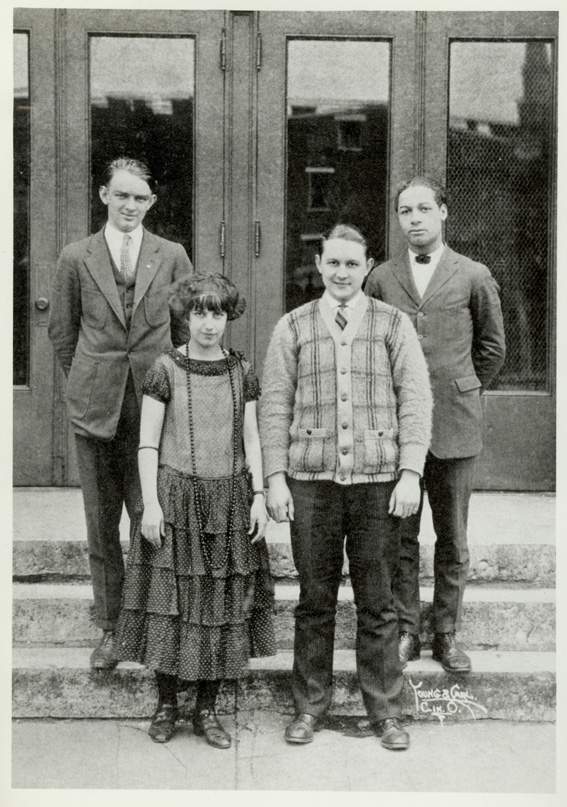
Theodore M. Berry with his Woodward High oration competitors Charlotte Lightfield, Nelson Murphy, and Aston Welsh, 1924
For those readers who have kept up at all with these blog posts, it will come as no surprise that Theodore M. Berry played a major role in aiding the civil rights movement in Ohio, and more particularly in Greater Cincinnati. What may be surprising to those who don’t know much about his life, though, is the way he went about it – firmly but politely and, most importantly, effectively. This was and continues to be, in this archivist’s humble opinion, one of his greatest contributions to the cause. For many people who were not witness to “the civil rights movement,” that term conjures images of the race riots which took place in Avondale, Detroit, and Watts during the 1960s, or of militant Black Panthers like those depicted in the film Forrest Gump. Berry, however, took a very different tack right from the start, believing the only way to extinguish the fire of discrimination would be to invalidate the prevailing stereotypes about African Americans which fed its flames. Well before he ever had the idea of becoming a city councilman, a personal liaison for a United States presidential candidate, or the director of a federal agency, Berry simply strove to be the best that he possibly could be. He broke down a number of walls in doing so.




